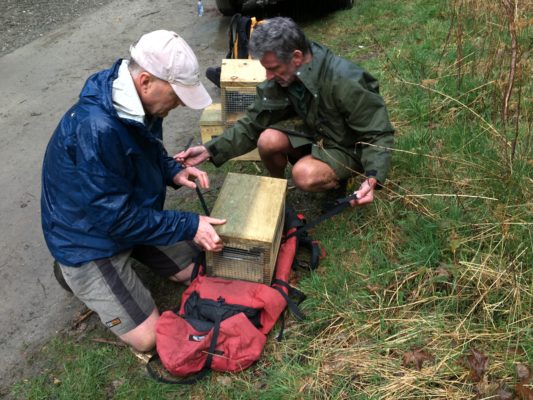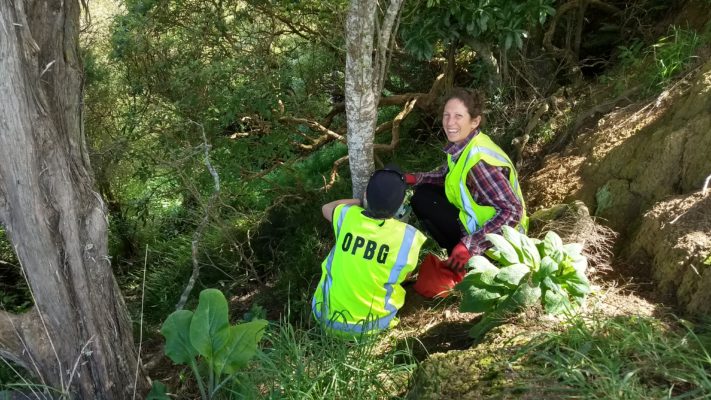From Auckland to Arrowtown and an assortment of towns and suburbs in between – the successful applicants for Round 3 of Kiwibank Predator Free Communities have just been announced.
Every winner has a different story, but the 12 successful community groups all have something in common: a determination to free their community of predators and welcome back the birds. Here’s how they each plan to do it:

Predator Free Arrowtown
Arrowtown is situated on the Arrow River in central Otago. It occupies a special niche, butted up against some high mountain ranges, valleys, and the river. A community meeting held in 2017 highlighted the trap network that already existed in the wider area. Residential backyards proved to be a significant gap in the control efforts around Arrowtown. There are around 1100 households in Arrowtown today, the predator free team aim to engage and encourage at least 20% of residents to start trapping in their own backyards in an effort to make Arrowtown township predator free by 2050.
Predator Free Okere Falls
This group of like-minded people want to make Okere Falls predator free by 2025.
Okere Falls is north of Rotorua and sits on the shores of Lake Rotoiti, at the inlet to the Kaituna River. They have identified three zones in the area, with three separate perimeters and they have a leader for each. The households are a mix of permanent residents and holiday homes.
Wild Aro
Is the name of this predator group located in the Aro Valley, a small inner-city suburb of Wellington. Their mission is to support the restoration of native birds through backyard trapping. They want to create a safe area from predators so native birds can establish themselves and recover. This will also assist with the prevention of reinvasion into neighbouring areas that have already successfully implemented predator controls, like in Polhill reserve which is on the border of Aro Valley.
Guardians of the Otago Peninsula (part of Otago Peninsula Biodiversity Group)
Situated at the neck of the Otago Peninsula, a long, hilly indented finger of land that forms the easternmost part of Dunedin sits the suburbs of Waverly, Shiel Hill, Vauxhall, Tainui and Andersons Bay. This team’s goal is to have a predator-free peninsula. These communities comprise of around 1500 households. They hope to enthuse 100 or more of them, particularly those adjacent to bushy corridors, to join the Guardians of the Otago Peninsula and help to meet their predator free goal.

Predator Free Bushglen Reserve
This group are already in the process of restoring the native bush around three stands of rare, fragile swamp maire trees in Bushglen Reserve which is located in Browns Bay, an Auckland suburb in the East Coast Bays area. Their plan is to engage with the local community, approximately 200 households neighbouring the reserve, with the aim of implementing a predator control border in residential backyards around the reserve.
Predator Free Cashmere
This is a suburb in Christchurch situated on the north side of the Port Hills, bordered on three sides by Victoria Park, Bowenvale Valley Park and Mount Vernon Parks. Their plan is to ring fence the lower slopes of the suburb from Victoria Park in the South to Cashmere Road in the North. They would like to see the eradication of rats, mustelids and possums in the hope that it brings back the birds and lizards. There’s an abundance of established native and exotic flora in the suburb that can feed native birds.
Brook Valley Trapping Group
Is located in The Brook Valley, Nelson. Their aim is to create a pest-free corridor for bird movements between the Grampians Reserve and the Brook Waimarama Sanctuary. They want to give the birds a chance to thrive without predators, especially rats, stoats and possums. Brook Valley is currently the gap with no trapping being done in the residential area to support the efforts of the reserve and the sanctuary.
Wanaka Backyard Trapping
Wanaka is a town situated in New Zealand’s South Island. Many conservation areas and farms that surround the communities of Wanaka, Albert Town and Hawea have already implemented strong volunteer-led trapping projects that have made an incredible difference to the number and diversity of the native species in the area. However, the neighbouring urban areas are the missing piece of the puzzle and this group intend to rectify that by setting up a backyard trapping program. They have noticed that their backyards host rats and that stoats and ferrets are commonly sighted on their roads.
Predator Free Westmere
A residential suburb of Auckland City, it has a natural boarder flanked on the west by Jaggers Bush and Meola Reef reserves, on the east by Cox’s Bay reserve and the at the north edge is Auckland harbour. Spurred on by neighbouring Predator Free Ponsonby and Grey Lynn, Westmere want to encourage everyone in their community to host a trap in their backyard and join the movement for New Zealand to become predator free by 2050.
Predator Free Morningside/Western Springs
Located in the inner west of Auckland it sits on the southern side of the northwestern motorway. This group are looking to focus their predator control efforts in two phases. Firstly, the North side of New North Road and then the South side. This suburb contains three parks and is in close proximity to several other parks, the zoo and a reserve. It’s an ideal habitat for native birds and reptiles, with the neighbourhood well suited to support and protect them with an urban backyards programme that targets rats and possums.
Fitzroy Beach Conservation Group
Fitzroy is a coastal suburb of New Plymouth, in the western North Island. Here they want to sleep to the sound of the surf and awake to the song of the birds by reducing / eliminating predators from the area. They plan to engage the residents of properties adjacent to the golf course, Holiday Park and the Waiwhakaiho River to join the movement by putting a trap in their own backyard.
Kitemo Street Community
Orakei is a suburb of Auckland city, in the North Island. It is located on a peninsula five kilometres to the east of the city centre, on the shore of the Waitematā Harbour. Kitemoana is a little street in the Orakei Ngati Whatua Community. The street leads to the Marae and their goal is to bring back native birds to the area by eradicating predators. There are around 80 homes in the street with all residents being related – whanau of some description so it won’t be hard to get everyone engaged.

